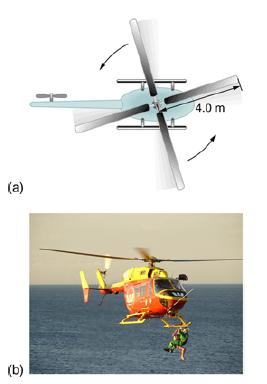A typical small rescue helicopter, similar to the one in Figure 10.17, has four blades, each is
Question:
A typical small rescue helicopter, similar to the one in Figure 10.17, has four blades, each is 4.00 m long and has a mass of 50.0 kg. The blades can be approximated as thin rods that rotate about one end of an axis perpendicular to their length. The helicopter has a total loaded mass of 1000 kg.
(a) Calculate the rotational kinetic energy in the blades when they rotate at 300 rpm.
(b) Calculate the translational kinetic energy of the helicopter when it flies at 20.0 m/s, and compare it with the rotational energy in the blades.
(c) To what height could the helicopter be raised if all of the rotational kinetic energy could be used to lift it?
Strategy
Rotational and translational kinetic energies can be calculated from their definitions. The last part of the problem relates to the idea that energy can change form, in this case from rotational kinetic energy to gravitational potential energy.

Step by Step Answer:






